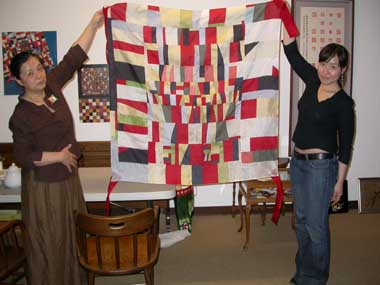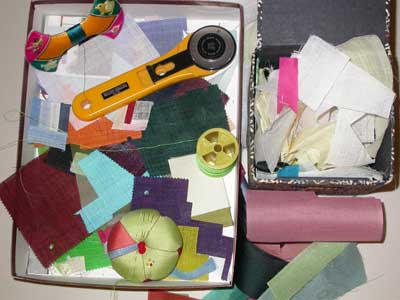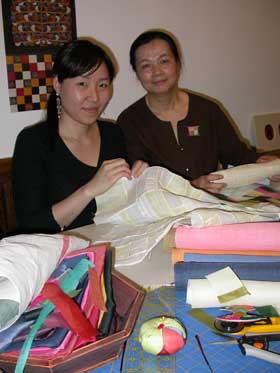 Amidst shopping boutiques, furniture shops, and gallery spaces along the La Brea corridor in Los Angeles, Los Angeles-based master artist Bonghwa Kim and her husband, Sung Y. Lee, run their gallery and studio Casa Muhyang, dedicated to traditional Korean arts including the Korean tea ceremony, ceramics, folk painting, flower arrangement, calligraphy, and textile arts. The latter includes traditions including pojagi (wrapping cloths used for storage) and chogak-po (patchwork). This year, Kim participated as a master artist in the Alliance’s Apprenticeship Program with apprentice Yejin Cha of Glendale, focusing on traditional patchwork techniques and embroidery through regular meetings at Casa Muhyang.
Amidst shopping boutiques, furniture shops, and gallery spaces along the La Brea corridor in Los Angeles, Los Angeles-based master artist Bonghwa Kim and her husband, Sung Y. Lee, run their gallery and studio Casa Muhyang, dedicated to traditional Korean arts including the Korean tea ceremony, ceramics, folk painting, flower arrangement, calligraphy, and textile arts. The latter includes traditions including pojagi (wrapping cloths used for storage) and chogak-po (patchwork). This year, Kim participated as a master artist in the Alliance’s Apprenticeship Program with apprentice Yejin Cha of Glendale, focusing on traditional patchwork techniques and embroidery through regular meetings at Casa Muhyang.
Patchwork textiles are reflective of the pragmatism and artistry in traditional Korean textile arts, with functional applications in covering or wrapping various items, from precious valuables and heirlooms to daily necessities. Each piece also varies based upon the needlework and color combinations and patterns which convey “traditional beauty and cultural affection with Korean solicitude and faith.” Through this work, Kim writes, “I learn presence of mind, concentration, and patience.”
Kim and Cha’s apprenticeship included both patchwork and embroidery, key needlework techniques which are specific to linen, silk, or ramie, and discussions about the forms’ history and the traditional principles and use of colors, composition, and philosophy within the pieces.
 Considered representative of the state of a woman’s spirit, chogak-po dates back at least to the 14th century, when women would meticulously collect leftover scraps of silk, cotton, ramie, or linen (all woven in the home by women) from making clothes, and artfully compose and stitch together the scraps to make pojagi, cloths used to wrap, cover, carry, and store items in the household. Pojagi vary in size and application, and would be used to contain the most mundane items such as bedding or clothing, to the most reverential such as Buddhist sutras. Today, chogak-po techniques are used either in the traditional utilitarian manner, or as wall hangings or table runners.
Considered representative of the state of a woman’s spirit, chogak-po dates back at least to the 14th century, when women would meticulously collect leftover scraps of silk, cotton, ramie, or linen (all woven in the home by women) from making clothes, and artfully compose and stitch together the scraps to make pojagi, cloths used to wrap, cover, carry, and store items in the household. Pojagi vary in size and application, and would be used to contain the most mundane items such as bedding or clothing, to the most reverential such as Buddhist sutras. Today, chogak-po techniques are used either in the traditional utilitarian manner, or as wall hangings or table runners.
Paired regularly with Kim and Cha’s labor intensive chogak-po and needlework lessons were the conducting of traditional Korean tea ceremony, which further provided a framework for their extensive conversations on women-based traditional arts in Korea. Like needlework, Kim articulated that the meditative tea ceremony is considered an integral companion to her textile work: “I lay all my devotion and prayers with every tiny stitch in the work. This became excellent meditation and it gave the opportunity of learning the beauty of tea ceremony, folk art, and traditional floral design.”
Since she was a young girl, Kim learned her skills in both tea ceremony and needlework directly from her mother, the traditional method of transmission. “All girls learned skills from their mothers and grandmothers and later they had to teach their own girls. Preserving this tradition, my mother passed her knowledge of needlework onto me.” Through her and her husband’s work exhibiting artists and offering classes in traditional Korean arts throughout the year at her Casa Muhyang, Kim wants to be sure to pass the traditions she learned onto the second generation and 1.5 generation Korean Americans who live in Los Angeles. She feels that certain Korean domestic traditions are “slowly [being] forgotten by young generations who [are] steeped in Western culture and I believe it is important for our next generations to experience the beauty of Korea’s history.” Her interest has been to ensure that these traditions can continue amongst younger, English-speaking Korean Americans, in addition to Korean immigrants living in the US, and offering a space for these practices to occur.
 Kim’s participation in the Apprenticeship Program with Cha is no exception to her interest in perpetuating these traditions, and Casa Muhyang became the site where they would work together, as well as the place where Cha initially met Kim. Upon their meeting, Cha was “entranced by [Kim’s] exquisite collection of work” and promptly began to learn from her. Cha, herself considered a 1.5 generation Korean American, feels that the apprenticeship with Kim has allowed her to “learn everything about what it means to be a Korean woman.”
Kim’s participation in the Apprenticeship Program with Cha is no exception to her interest in perpetuating these traditions, and Casa Muhyang became the site where they would work together, as well as the place where Cha initially met Kim. Upon their meeting, Cha was “entranced by [Kim’s] exquisite collection of work” and promptly began to learn from her. Cha, herself considered a 1.5 generation Korean American, feels that the apprenticeship with Kim has allowed her to “learn everything about what it means to be a Korean woman.”
Musing on the impact her studies with Kim have had in her life as a young, urban woman in Los Angeles, Cha notes that “in a busy, hectic life, focused on making a buck, each stitch becomes a prayer.” Kim noted Cha’s “particular interest and understanding in Korean culture,” believing that “she will be an outstanding artist succeeding our traditional culture.” As a result of their apprenticeship, they shared their work in the unprecedented exhibition Walking on the Same Path at the Korean Cultural Center in Los Angeles, sharing the show with master African-American quiltmaker and former Apprenticeship Program master artist Allyson Allen.
